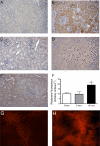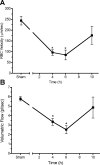Hemodynamic changes in the kidney in a pediatric rat model of sepsis-induced acute kidney injury
- PMID: 21511700
- PMCID: PMC3129882
- DOI: 10.1152/ajprenal.00687.2010
Hemodynamic changes in the kidney in a pediatric rat model of sepsis-induced acute kidney injury
Abstract
Sepsis is a leading cause of acute kidney injury (AKI) and mortality in children. Understanding the development of pediatric sepsis and its effects on the kidney are critical in uncovering new therapies. The goal of this study was to characterize the development of sepsis-induced AKI in the clinically relevant cecal ligation and puncture (CLP) model of peritonitis in rat pups 17-18 days old. CLP produced severe sepsis demonstrated by time-dependent increase in serum cytokines, NO, markers of multiorgan injury, and renal microcirculatory hypoperfusion. Although blood pressure and heart rate remained unchanged after CLP, renal blood flow (RBF) was decreased 61% by 6 h. Renal microcirculatory analysis showed the number of continuously flowing cortical capillaries decreased significantly from 69 to 48% by 6 h with a 66% decrease in red blood cell velocity and a 57% decline in volumetric flow. The progression of renal microcirculatory hypoperfusion was associated with peritubular capillary leakage and reactive nitrogen species generation. Sham adults had higher mean arterial pressure (118 vs. 69 mmHg), RBF (4.2 vs. 1.1 ml·min(-1)·g(-1)), and peritubular capillary velocity (78% continuous flowing capillaries vs. 69%) compared with pups. CLP produced a greater decrease in renal microcirculation in pups, supporting the notion that adult models may not be the most appropriate for studying pediatric sepsis-induced AKI. Lower RBF and reduced peritubular capillary perfusion in the pup suggest the pediatric kidney may be more susceptible to AKI than would be predicted using adults models.
Figures







Similar articles
-
Development of oxidative stress in the peritubular capillary microenvironment mediates sepsis-induced renal microcirculatory failure and acute kidney injury.Am J Pathol. 2012 Feb;180(2):505-16. doi: 10.1016/j.ajpath.2011.10.011. Epub 2011 Nov 24. Am J Pathol. 2012. PMID: 22119717 Free PMC article.
-
Increase in endothelial microparticles is negatively correlated with decrease in renal microperfusion in septic rats.Microvasc Res. 2025 Jul;160:104809. doi: 10.1016/j.mvr.2025.104809. Epub 2025 Apr 3. Microvasc Res. 2025. PMID: 40187486
-
Rolipram improves renal perfusion and function during sepsis in the mouse.J Pharmacol Exp Ther. 2013 Nov;347(2):357-64. doi: 10.1124/jpet.113.208520. Epub 2013 Sep 9. J Pharmacol Exp Ther. 2013. PMID: 24018639 Free PMC article.
-
Sepsis-associated acute kidney injury: macrohemodynamic and microhemodynamic alterations in the renal circulation.Semin Nephrol. 2015 Jan;35(1):64-74. doi: 10.1016/j.semnephrol.2015.01.007. Semin Nephrol. 2015. PMID: 25795500 Review.
-
Renal Medullary Hypoxia: A New Therapeutic Target for Septic Acute Kidney Injury?Semin Nephrol. 2019 Nov;39(6):543-553. doi: 10.1016/j.semnephrol.2019.10.004. Semin Nephrol. 2019. PMID: 31836037 Review.
Cited by
-
Therapeutic translation in acute kidney injury: the epithelial/endothelial axis.J Clin Invest. 2014 Jun;124(6):2355-63. doi: 10.1172/JCI72269. Epub 2014 Jun 2. J Clin Invest. 2014. PMID: 24892710 Free PMC article. Review.
-
Could Biomarkers Direct Therapy for the Septic Patient?J Pharmacol Exp Ther. 2016 May;357(2):228-39. doi: 10.1124/jpet.115.230797. Epub 2016 Feb 8. J Pharmacol Exp Ther. 2016. PMID: 26857961 Free PMC article. Review.
-
Pathophysiology and management of septic acute kidney injury.Pediatr Nephrol. 2014 Jan;29(1):1-12. doi: 10.1007/s00467-013-2427-6. Epub 2013 Feb 12. Pediatr Nephrol. 2014. PMID: 23400860 Review.
-
Epidemiological characteristics of and risk factors for patients with postoperative acute kidney injury: a multicenter prospective study in 30 Chinese intensive care units.Int Urol Nephrol. 2018 Jul;50(7):1319-1328. doi: 10.1007/s11255-018-1828-7. Epub 2018 Feb 26. Int Urol Nephrol. 2018. PMID: 29480442
-
Use of Biotelemetry to Define Physiology-Based Deterioration Thresholds in a Murine Cecal Ligation and Puncture Model of Sepsis.Crit Care Med. 2016 Jun;44(6):e420-31. doi: 10.1097/CCM.0000000000001615. Crit Care Med. 2016. PMID: 26862708 Free PMC article.
References
-
- Baker M, Wayland H. On-line volume flow rate and velocity profile measurement for blood in microvessels. Microvasc Res 7: 131–143, 1974 - PubMed
-
- Brophy PD. Renal supportive therapy for pediatric acute kidney injury in the setting of multiorgan dysfunction syndrome/sepsis. Sem Nephrol 28: 457–469, 2008 - PubMed
-
- Calkins CM, Bensard DD, Partrick DA, Karrer FM, McIntyre RC. Altered neutrophil function in the neonate protects against sepsis-induced lung injury. J Pediatr Surg 37: 1042–1047, 2002 - PubMed
-
- Carcillo JA, Fields AI. Clinical practice parameters for hemodynamic support of pediatric and neonatal patients in septic shock. Crit Care Med 30: 1365–1378, 2002 - PubMed
-
- Chin A, O'Conner LN, Radhakrishnan J, Fornell L, John E. Endotoxemia and the effects of dopamine on renal functions of neonatal piglets. Biol Neonate 81: 196–202, 2002 - PubMed
Publication types
MeSH terms
Substances
Grants and funding
LinkOut - more resources
Full Text Sources
Medical
Miscellaneous

